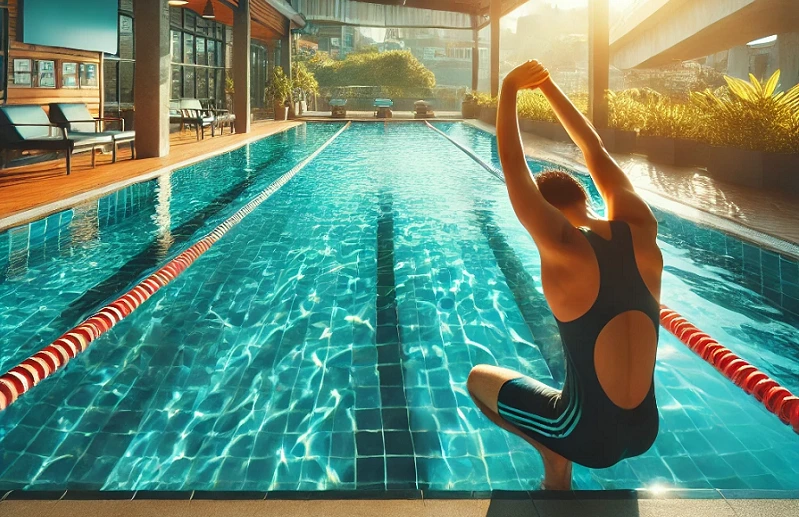
How to Clean a Swimming Pool in Australia: A Step-by-Step Guide
Swimming pools are one of the best parts of living in Australia. Whether you’re splashing around in the summer heat

Swimming is one of the best low-impact exercises that provide a full-body workout while being gentle on the joints. Whether you’re swimming for exercise to build endurance, improve cardiovascular health, or tone muscles, it’s crucial to ensure that you’re doing it safely. Following essential safety tips for swimmers can help prevent injuries, maintain hygiene, and maximize the benefits of your workouts. Here are five ways to protect your body while swimming safely.
Just like any other workout, warming up before swimming is essential to prevent muscle cramps and injuries. Many swimmers overlook this step, but preparing your body for movement in the water is key to swimming safely.
1. It increases blood circulation and prepares muscles for movement.
2. Reduces the risk of muscle cramps and strains.
3. Enhances flexibility and range of motion.
1. Arm circles and shoulder rolls to loosen up upper body muscles.
2. Leg swings and lunges to activate leg muscles.
3. Neck stretches to reduce stiffness.
4. A few minutes of light cardio, such as jogging in place, to elevate heart rate.
Taking a few minutes to warm up and stretch can help you swim more efficiently and safely, reducing the risk of injury.
Incorrect swimming techniques can lead to unnecessary strain on your body, increasing the risk of injuries. Learning and practicing proper form will help you swim for exercise without harming your joints or muscles.
1. Maintain Proper Body Alignment: Keep your head, hips, and feet aligned to avoid neck and back strain.
2. Use a Balanced Stroke: Whether you’re doing freestyle, breaststroke, or backstroke, ensure that your strokes are even and controlled.
3. Engage Your Core Muscles: A strong core helps maintain balance and reduces pressure on the lower back.
4. Avoid Overexertion: Pushing yourself too hard can cause fatigue and increase the risk of accidents in the water.
If you’re new to swimming for exercise, consider taking lessons from a certified instructor to learn the correct techniques and improve your efficiency.
Swimming in a clean pool is essential for preventing infections and skin irritations. Dirty or chemically imbalanced water can lead to health issues, including respiratory problems, eye irritation, and bacterial infections.
1. Regularly test and balance pH and chlorine levels.
2. Remove debris and vacuum the pool frequently.
3. Shower before entering the pool to reduce contaminants.
Ensure proper filtration and circulation to keep water fresh.
If you’re swimming in a public pool, choose one that follows strict hygiene standards. Always rinse off after swimming to remove chlorine and bacteria from your skin.
Checkout: best robotic Pool Cleaner in Australia
Many swimmers underestimate the importance of staying hydrated while in the water. Even though you may not feel sweaty, your body loses fluids, which can lead to dehydration.
1. Drink plenty of water before and after swimming.
2. Avoid caffeine or alcohol before swimming, as they can lead to dehydration.
3. Eat a light, nutritious snack, such as a banana or yogurt, to maintain energy levels.
Additionally, listen to your body and take breaks when needed. If you feel dizzy, fatigued, or experience muscle cramps, stop immediately and rest.
Prolonged exposure to chlorinated water and the sun can take a toll on your skin and eyes. Proper protection will help you swim comfortably and prevent long-term damage.
1. Apply a water-resistant, broad-spectrum sunscreen before swimming outdoors.
2. Wear a swim cap to reduce hair exposure to chlorine and saltwater.
3. Shower immediately after swimming and apply moisturizer to keep your skin hydrated.
1. Use high-quality swimming goggles to protect your eyes from chlorine and prevent irritation.
2. Choose goggles with UV protection if swimming outdoors.
3. Rinse your eyes with fresh water after swimming to remove chlorine residues.
By taking care of your skin and eyes, you can swim for exercise without discomfort or damage.
Swimming for exercise is an excellent way to stay fit and healthy, but it’s important to follow safety tips for swimmers to prevent injuries and health issues. Warming up, using proper techniques, keeping your pool clean, staying hydrated, and protecting your skin and eyes are crucial steps to swimming safely. By incorporating these practices, you can enjoy a safe and effective workout in the water while maintaining your overall well-being.
Remember, swimming safely ensures that you get the most out of your exercise routine while minimizing risks. So, dive in, stay safe, and enjoy the benefits of swimming for exercise!

Swimming pools are one of the best parts of living in Australia. Whether you’re splashing around in the summer heat

Australia’s swimming season may slow down in winter, but your pool still needs attention. Neglecting care during the colder months
